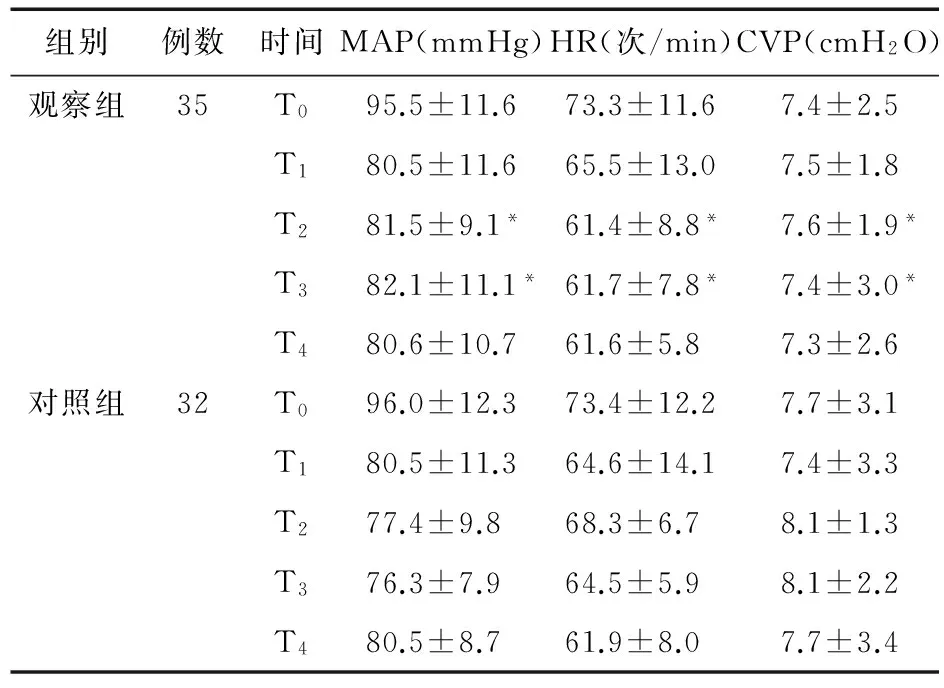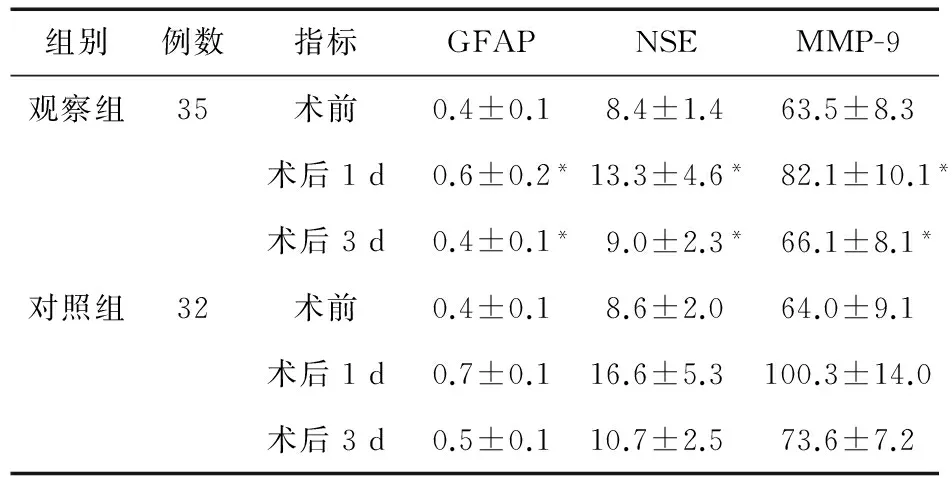右美托咪定在颈椎手术中的脊髓保护作用
滕成玲,吕德珍,赵 玉
右美托咪定在颈椎手术中的脊髓保护作用
滕成玲,吕德珍,赵玉*
目的探讨右美托咪定对颈椎手术患者的脊髓保护作用及其作用机制。方法选择2012年11月至2014年12月在我院麻醉科拟在全麻辅助下行颈椎手术的67例患者,记录炎性指标、生命体征、脊髓功能等。随机分为观察组(右美托咪定组,35例)和对照组(生理盐水组,32例)。比较两组患者的术中生命体征、术前及术后的炎性指标、神经元损伤相关指标及脊髓神经功能。结果T0(麻醉诱导前)、T1(输注右美托咪定或生理盐水前)、T4(拔除喉罩后)时,两组患者的MAP、HR及CVP比较差异无统计学意义(P>0.05);T2(右美托咪定负荷量静注后15 min)、T3(手术开始后10 min)时,观察组MAP高于对照组,HR、CVP低于对照组(P<0.05)。术前两组患者的炎性指标、脊髓功能指标比较差异无统计学意义(P>0.05);术后1 d、3 d时,观察组TNF-α、IL-6、CRP、GFAP、NSE及MMP-9水平均低于对照组(P<0.05)。术后7 d时,观察组患者JOA评分高于对照组(14.9±3.0 vs.14.0±2.1,P<0.05)。结论右美托咪定能缓解颈椎术后脊髓继发损伤的程度,具有脊髓保护功能。
右美托咪定;颈椎手术;脊髓;保护作用
0 引言
脊柱病变常导致脊髓及神经根的压迫,出现自主神经、躯体感觉运动等功能障碍,严重影响患者的身心健康及生活质量[1]。目前,手术为主的综合治疗是脊柱病变的主要治疗策略,而解除脊髓压迫、维持其稳定性是主要的手术目标[2]。但手术及麻醉应激、缺血再灌注损伤等因素可导致对脊髓的继发性损害,严重影响了手术疗效及患者预后[3]。右美托咪定是临床麻醉中应用非常广泛的镇静、止痛药物,具有显著的心脑等脏器保护作用[4],但其对患者的脊髓保护作用尚没有明确报道,本文就此方面开展研究,现报道如下。
1 资料与方法
1.1研究对象本研究经本院医学伦理委员会批准后施行。收集2012年11月至2014年12月在我院麻醉科拟在全麻辅助下行颈椎手术的患者的相关资料。入组标准:①18~ 60岁;②近期无α2受体激动剂使用史;③无心律失常、心功能不全等心脏相关疾病史。排除标准:①伴四肢功能障碍或残疾者;②伴有肝肾功能不全或血液系统疾病者;③伴颅脑创伤、感染、器质性病变或精神障碍者;④伴脊髓损伤的中枢神经症状。患者均签署研究知情同意书。
1.2研究方法入组患者术前均常规禁食禁水。术前0.5 h肌注0.08 mg/kg盐酸戊已奎醚,入手术室后监测常规生命体征。面罩吸氧,静注0.2 mg/kg依托咪酯、0.5 μg/kg舒芬太尼、0.05 mg/kg咪达唑仑,患者失去意识后予0.6 mg/kg罗库溴铵静注,实施全麻、气管插管,接麻醉机予机械通气,容量控制模式,设定参数:潮气量8~10 mg/kg,氧浓度60%,流量2 L/min,呼气末CO235~45 mmHg。麻醉维持采用全凭静脉麻醉,瑞芬太尼、异丙酚靶控输注,顺式阿曲库铵0.1~0.2 mg/(kg·h)持续输注。
纳入78例患者,其中11例患者因依从性、配合性差等因素而剔除出组。其余67例患者根据随机数表法随机分为2组。观察组35例,术前予0.6 μg/kg右美托咪定(购自四川国瑞药业公司) 15 min内静注,随后以2.0 mg/(kg·h)持续泵注,直至手术结束。对照组32例,给予相同剂量的生理盐水输注。术中密切观察血流动力学参数、BIS值等指标,评估患者的麻醉深度,并调整药物。
1.3观察指标术中生命体征监测:在不同的时间点,包括T0(麻醉诱导前)、T1(输注右美托咪定或生理盐水前)、T2(右美托咪定负荷量即单次剂量0.6 μg/kg静注后15 min)、T3(手术开始后10 min)、T4(拔除喉罩后),监测并记录患者的生命体征,包括平均动脉压(MAP)、中心静脉压(CVP)和心率(HR)。
炎性指标检测:术前及术后1 d、3 d时,在空腹下、清晨抽取外周静脉血,采用ELISA法检测白介素-6 (IL-6)、肿瘤坏死因子-α (TNF-α)、C-反应蛋白(CRP)及血沉(ESR)。
神经元损伤相关指标检测:术前及术后1 d、3 d时,血样采集与炎性指标相同,采用ELISA法检测GFAP(神经胶质纤维酸性蛋白)、MMP-9(基质金属蛋白酶-9)和NSE(神经元特异性烯醇化酶),检测方法严格遵循试剂说明书。
脊髓神经功能评估:于术前、术后7 d时采用日本矫形科学学会(JOA)评分标准对脊髓神经功能进行评价[5]。

2 结果
2.1临床资料两组患者一般资料比较差异无统计学意义(P>0.05)。见表1。

表1 两组患者临床资料比较(例)
2.2两组患者各时间点生命体征比较由表2可见,在T0、T1、T4时,两组患者的MAP、HR及CVP比较差异均无统计学意义(P>0.05),而在T2、T3时,观察组患者的MAP高于对照组,HR、CVP低于对照组(P<0.05)。
2.3两组患者术前、术后炎性指标比较术前两组患者各项炎性指标比较差异均无统计学意义(P>0.05);而在术后1 d、3 d时,观察组TNF-α、IL-6及CRP水平均低于对照组(P<0.05)。见表3。
2.4两组患者术前、术后脊柱功能比较两组患者术前、术后神经元损伤相关指标(包括GFAP、NSE、MMP-9)比较见表4。结果显示,术前两组患者各项指标比较差异均无统计学意义(P>0.05),而术后1 d、3 d时,观察组患者的GFAP、NSE、MMP-9水平均低于对照组(P<0.05)。观察组与对照组患者术前JOA评分比较差异无统计学意义(11.6±3.4 vs.11.8±4.0,P>0.05),而术后7 d时,观察组患者JOA评分高于对照组(14.9±3.0 vs.14.0±2.1,P<0.05)。

表2 两组患者各时间点生命体征比较
注:*与对照组比较,P<0.05

表3 两组患者术前、术后炎性指标比较
注:*与对照组比较,P<0.05

表4 两组患者术前、术后脊柱功能相关指标比较(ng/mL)
注:*与对照组比较,P<0.05
3 讨论
脊髓继发性损伤是颈椎手术后较为常见的并发症之一,其继发性损伤的明确病理机制尚未明确,可能的发病机制包括术后出现神经元凋亡、钙内流、氨基酸毒性、脊髓微循环障碍、氧自由基积聚致脂质过氧化等因素[6]。右美托咪定是一种新型的特异性及选择性较高的α2受体激动剂,主要作用于脊髓、脑受体[7],本研究主要探讨其在颈椎手术中对脊髓的保护作用。
本研究结果显示,T0、T1、T4时,两组术中生命体征包括MAP、CVP及HR比较差异无统计学意义,而T2、T3时,两组各项指标比较差异有统计学意义,与对照组比较,观察组患者的MAP、CVP及HR在手术过程中均比较稳定,提示右美托咪定在维持血流动力学参数稳定中有积极的意义。术前、术后的炎性指标比较结果显示,在术后1 d、3 d时,观察组患者的TNF-α、IL-6及CRP水平低于对照组,提示右美托咪定能够显著抑制患者机体的炎症反应[8]。
目前,已有研究表明,GFAP、MMP-9及NSE是反映中枢神经功能损伤的重要和有效的指标[9]。其中GFAP是星形胶质细胞的标志性蛋白,其与髓鞘形成、星形细胞的形态、功能的维持、血脑屏障完整性的维持、细胞黏附、骨架重组等均有重要关系,且其能够通过血脊髓屏障,能够间接反映脑、脊髓的损伤程度[10]。MMP-9对于血脊髓、血脑屏障完整性的维持有重要意义,在脊髓的继发性损伤中发挥重要作用。研究证实,脊髓损伤时,MMP-9水平明显升高,且其升高幅度与脊髓损伤的程度呈正相关[11]。NSE是一种糖酵解过程中的关键酶,为神经内分泌细胞和神经元特有。大量研究已证实,NSE的升高与神经系统损伤呈正相关,且提示预后不良[12]。本研究比较了两组患者GFAP、MMP-9及NSE水平,结果显示,术前两组比较差异无统计学意义,而在术后1 d、3 d时观察组低于对照组,提示观察组患者的术后脊髓损伤程度小于对照组,而术后7 d的JOA评分结果同样证实了上述观点。结果表明,右美托咪定能够在一定程度上缓解术后脊髓继发损伤的程度,其保护机制可能与右美托咪定减轻炎症反应、维持血流动力学稳定有关,但右美托咪定的确切脊髓保护作用及机制还有待进一步的研究探讨。
[1]Farghaly HS,Abd-Ellatief RB,Moftah MZ,et al.The effects of dexmedetomidine alone and in combination with tramadol or amitriptyline in a neuropathic pain model[J].Pain Physician,2014,17(2):187-195.
[2]Mariappan R,Ashokkumar H,Kuppuswamy B.Comparing the effects of oral clonidine premedication with intraoperative dexmedetomidine infusion on anesthetic requirement and recovery from anesthesia in patients undergoing major spine surgery[J].J Neurosurg Anesthesiol,2014,26(3):192-197.
[3]Huang Y,Lu Y,Zhang L,et al.Perineural dexmedetomidine attenuates inflammation in rat sciatic nerve via the NF-kappaB pathway[J].Int J Mol Sci,2014,15(3):4049-4059.
[4]Zhou TT,Wu JR,Chen ZY,et al.Effects of dexmedetomidine on P2X4Rs,p38-MAPK and BDNF in spinal microglia in rats with spared nerve injury[J].Brain Res,2014,1568:21-30.
[5]Kabalak A,Ekmekcioglu E,Ceylan A,et al.The synergistic antinociceptive interactions of morphine and dexmedetomidine in rats with nerve-ligation injury[J].Hippokratia,2013,17(4):326-331.
[6]Xiang H,Hu B,Li Z,et al.Dexmedetomidine controls systemic cytokine levels through the cholinergic anti-inflammatory pathway[J].Inflammation,2014,37(5):1763-1770.
[7]Plambech MZ,Afshari A.Dexmedetomidine in the pediatric population:a review[J].Minerva Anestesiol,2015,81(3):320-332.
[8]Chen Z,Lin S,Shao W.Effects on somatosensory and motor evoked potentials of senile patients using different doses of dexmedetomidine during spine surgery[J].Ir J Med Sci,2015,184(4):813-818.
[9]Kido H,Komasawa N,Fujiwara S,et al.Gasserian ganglion block for trigeminal neuralgia under dexmedetomidine sedation[J].Masui,2014,63(8):901-903.
[10]Keane MJ,Manikappa S,Alrawi NN.Observational study of dexmedetomidine for hysteroscopy,cystoscopy and transrectal ultrasound biopsy[J].Anaesth Intensive Care,2014,42(1):23-27.
[11]Terao Y,Ichinomiya T,Higashijima U,et al.Comparison between propofol and dexmedetomidine in postoperative sedation after extensive cervical spine surgery[J].J Anesth,2012,26(2):179-186.
[12]Demuro JP,Botros D,Nedeau E,et al.Use of dexmedetomidine for postoperative analgesia in spine patients[J].J Neurosurg Sci,2013,57(2):171-174.
Analysis of spinal protection of dexmedetomidine during cervical surgery
TENG Cheng-ling,LÜ De-zhen,ZHAO Yu*
(Department of Anesthesiology,Nanjing General Hospital of Nanjing Military Command,Nanjing 210002,China)
ObjectiveTo discuss the spinal protection of dexmedetomidine for patients with cervical surgery and its mechanisms.MethodsTotally 67 patients undergoing cervical spine surgery under general anesthesia in our hospital from November 2012 to December 2014 were randomly divided into two groups,patients in observation group(n=35) were given dexmedetomidine before the operation,and patients in control group (n=32) received the same amount of normal saline. The intraoperative vital signs,inflammatory indexes,neuron damage correlated indexes and spinal nerve function before and after operation in the two groups were compared. ResultsThere was no significant difference in the levels of MAP,HR and CVP at T0(before anesthesia induction),T1(before the infusion of dexmedetomidine or normal saline) and T4(after removal laryngeal mask) between the two groups (P>0.05);the MAP in observation group was higher than that of control group at T2(15 min after infusion of loading dexmedetomidine) and T3(10 min after the beginning of operation),and the levels of HR and CVP were lower. No significant difference was observed in the inflammatory indexes and spinal cord function between the two groups preoperatively (P>0.05);the levels of TNF-α,IL-6,CRP,GFAP,NSE and MMP-9 in observation group were lower than those of control group at 1 d and 3 d after the surgery (P<0.05). The JOA score in observation group was higher than that of control group at 7 d after the surgery (P<0.05).ConclusionDexmedetomidine can alleviate the degree of secondary spinal cord injury after cervical surgery and protect the spinal cord function.
Dexmedetomidine;Cervical surgery;Spinal cord;Protection effect
2015-12-15
南京军区南京总医院麻醉科,南京 210002
10.14053/j.cnki.ppcr.201608012

